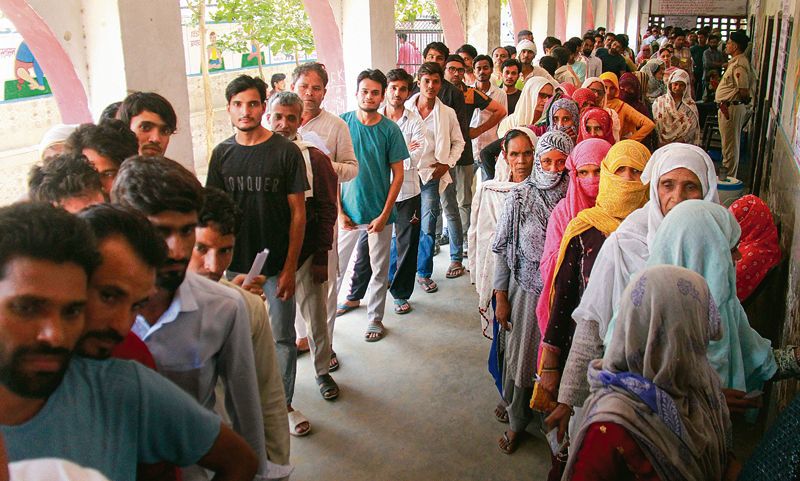Anti-incumbency, Congress surge to test BJP’s mettle in Haryana polls
THE outcome of the Lok Sabha elections in Haryana, where the ruling BJP and the Congress won five seats each, has set the stage for a tight contest in the Assembly elections later this year. As parties vie for victory, key factors in the parliamentary elections, shifting caste dynamics and the evolving political equations in the state demand close attention.
Local issues took precedence over national ones in the recent Lok Sabha elections in Haryana. The ‘Modi factor’, which the BJP heavily relies upon, appeared less potent in mobilising the electorate. The charisma of PM Narendra Modi and the promotion of the party’s state-level achievements did not resonate with many voters. The party also struggled to consolidate the vote of labharthis or beneficiaries of Central schemes. This, coupled with a decade of the BJP’s rule, created strong anti-incumbency sentiments. The Congress capitalised on issues like unemployment, inflation, misconduct with women wrestlers and the Agnipath scheme. The scheme significantly impacted a section of the voters, as Haryana is a major recruitment hub for the armed forces. Moreover, discrepancies in the Parivar Pehchan Patra, a family ID card meant to streamline welfare schemes, hurt the BJP. The party also faced a backlash from farmers, who were ruthlessly deterred from entering Delhi to put forth their demand for a legal guarantee of MSP (minimum support price).
The caste vote indicated two important shifts. One, the traditional Congress voter base is intact and has achieved significant consolidation. Two, the Jat voter has begun to support the Congress once again. Eyeing the sizeable OBC vote and sensing anti-incumbency, the BJP had replaced Manohar Lal Khattar with Nayab Singh Saini as the CM months before the Lok Sabha elections. While Khattar registered an emphatic win in his constituency, the replacement of the CM face bore no major results. According to the Lokniti-CSDS data, one in every two OBC voters voted for the Congress, a 29 per cent increase from the 2019 General Election. This indicates a shift in the BJP’s core voter base. While the party retained its upper-caste vote, including Brahmins, Punjabis and Rajputs, it lost its Scheduled Caste (SC) vote to the Congress. Traditionally, the SC vote has been split between the BJP and the Bahujan Samaj Party (BSP). But this time, a majority of the Dalits backed the Congress. The minority vote also favoured the Congress, suggesting that the anti-BJP sentiment has coalesced into a broad social coalition for the Congress.
The Jat community, accounting for about one-fourth of Haryana’s population, has historically dominated state politics. As a key social group, they hold considerable leverage. The Lokniti-CSDS data indicates that the Congress successfully mobilised Jat voters, with two in every three Jats voting for the party — a 31 per cent increase from the 2019 elections. One strong indication of this consolidation is that the grand old party won all seats in the Jat belt, including Hisar, Sirsa, Sonepat and Rohtak. Arguably, this shift not only highlights the declining influence of regional parties like the Jannayak Janta Party (JJP) and the Indian National Lok Dal (INLD) — which often rely on the Jat vote — but it also shows the growing dissatisfaction with the BJP among the Jats.
A shift towards a two-party system in Haryana was evident in the Lok Sabha elections. The BJP has minimised the space for regional parties, which initially helped it gain a foothold in the state. The BJP entered Haryana politics as a lesser partner to the Lok Dal and the Haryana Vikas Party. Over time, however, the BJP built a consistent voter base, pushing these parties to the brink of oblivion. For instance, in the 2024 elections, both the INLD and the JJP suffered significant defeats, with a combined vote share below 3 per cent. It appears that Haryana, much like Rajasthan and Himachal Pradesh, is moving towards a two-party system if the regional parties continue to perform poorly.
All these factors have implications for the Assembly elections. Firstly, most local issues remain unaddressed. The party that understands and addresses these issues will likely prevail in the Vidhan Sabha polls. Secondly, the Jat voter in Sirsa and Hisar — previously INLD strongholds — has favoured the Congress. It remains to be seen what manoeuvres the INLD and its offshoot, the JJP, will use to reclaim their space in these constituencies at the Assembly level. Thirdly, despite their poor performance in the Lok Sabha elections, the INLD and the JJP have a significant presence at the Assembly level. They must engage with the electorate in ways distinct from the Congress and the BJP to remain relevant. Thirdly, this election did not witness victory margins above one lakh votes, barring Rohtak, Karnal, Sirsa and Faridabad. In other constituencies, voters did not decisively vote for a single party, and, resultantly, the votes were split. This makes room for parties like the INLD and JJP to find ways to outmanoeuvre others. Ruling out any alliance, the Aam Aadmi Party has decided to go solo and contest all 90 seats in Haryana.
The alliance between the INLD and the BSP raises questions about its effectiveness in securing its core voter base — the Jats and Dalits. It remains to be seen whether this coalition will yield dividends for the parties or if these votes will once again be divided in the Assembly elections. In a recent interview, newly elected Sirsa MP Selja Kumari hinted at infighting in the state Congress. A weak leadership at the state level could translate into losses for the party. However, one thing is crystal clear: the Congress, which managed to perform well in the Lok Sabha elections, has the potential to sustain this momentum in the Assembly polls. To do so, the party must engage in introspection, identify its shortcomings and address them effectively.









